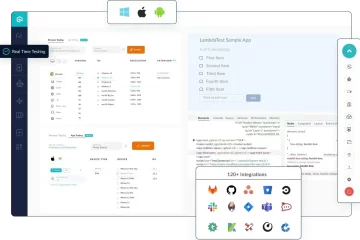How Can Regression Testing And Retesting Methods Improve Software Verification And Validation?

Testing software is an essential procedure to ensure software’s functionality, quality, and security. But testing software isn’t a one-time process. It requires continuous evaluation, improvement, and monitoring to adapt to constantly changing specifications, requirements, and environments.
One of the most popular and efficient methods for testing software that will help you achieve this aim includes retesting and regression testing.
Through this post, you’ll learn about these techniques, how they differ, and how you can enhance the quality of your software verification and validation through regression testing.
Table of Contents
What is Regression Testing?
Regression testing can be described as a quality control procedure that checks whether any recent updates or modifications to software have accidentally caused new errors or negatively affected previously functional elements.
The primary objective of regression testing is to ensure that changes intended to improve performance are not affecting the established functionality and dependability of the application.
Through conducting tests of regression, software teams ensure the stability and smooth operation of their software and increase confidence in their ongoing efforts to develop.
Regression testing is an essential element of software development’s quality control procedures.
Each time a modification is made, it’s tested to be sure that the change does not accidentally cause any issues with performance or functionality.
When performing this type of testing, developers aim to discover and solve a problem that has been recurring, which is the return of previous issues caused through the implementation of new changes to code.
Regression testing is essentially a security measure, aiding in maintaining the trustworthiness and stability of software during its continuous development.
If software developers want to fix a flaw, introduce new functionality, or change the functionality or features of an existing program in their software, they have to modify the program’s code. Any slight modification will likely lead to a multitude of bugs.
In such a case, the Test Engineer can identify and highlight adverse side effects using regression tests. A well-executed regression test suite is essential. It is crucial that following fixing a problem is implemented, the original program is not unable to function.
What is Retesting?
Retesting is a vital procedure for testing software where certain tests are run again to ensure the issues identified in the previous tests were corrected properly.
It helps to confirm that changes or bug fixes don’t create new problems. Retesting ensures the stability and quality of software before the release.
It’s part of the defect lifecycle where unsuccessful test cases are conducted and were ineffective before the previous test fix by the developers.
The process of testing as an integral part of the life-cycle of testing software is of a number of importance to the successful execution of the product.
In fact, it is the most important element of the normal software testing procedure. It provides the software with extra assurance by evaluating its functional and technical performance before releasing it to end users.
Companies must ensure high-quality digital applications in the highly aggressive market for software development. This means that there must be no compromise on how the product is made.
Automated testing platforms can aid in getting a higher return on investment for the product you have released.
But, retesting gives greater assurance by confirming each glitch. Compared to the initial test, it neither increases the cost of testing resources nor takes a lot of time. It is performed in the same setting using similar information related to unsuccessful tests.
Furthermore, the retesting process will address particular bugs or issues found in particular application modules. This means that you don’t have to create a new testing environment, and you can put in more time to test the quality of the product through end-to-end testing.
Improve Software Verification And Validation Through Regression Testing and Retesting Methods
Regression testing and retesting are the two vital elements of validation and verification for software. They are crucial in guaranteeing the reliability and quality of software.
Here are a few key methods by which regression testing as well as retesting could help improve the software validation and verification process:
- Recognizing Regressions: Regression testing aids in identifying any new problems or defects that could be introduced because of recent code modifications. It makes sure that the software will continue to function properly following modifications.
- Preventing Unintentional Side Effects: Running a set of test cases that are predefined regression testing helps to stop unintended side effects and interactions between different software components, which can cause issues with previously functional features.
- Stability: It contributes to the overall stability of the software by ensuring that the features in place are functional and don’t degrade with time.
- Continuous Quality Control Tests for regression are generally automated, allowing continuous surveillance of the performance and reliability, allowing it to spot issues earlier.
- Rapider Development and Deployment: Developers can have greater confidence when making changes to the codebase as they can quickly confirm that the changes did not cause new problems, thus allowing rapid development and deployment.
On the other hand, when it comes to retesting:
- Verifying Bug fixes: Retesting is specifically designed to ensure that any problems or issues that have been reported have been fixed successfully. This confirms that the issue has been eliminated in the latest version.
- Validating Changes: After bug fixes or changes are made, retesting helps verify that these modifications didn’t accidentally create new problems or negatively affect other program components.
- Enhancing the Reliability of Software: Retesting can increase the program’s overall functionality and reliability by confirming that certain issues have been dealt with and solved.
- Customer Satisfaction: Ensuring any problems are addressed by retesting could result in higher customer satisfaction and an improved user experience.
- Documentation of test cases: Retesting typically involves logging the test case and procedure procedures, ensuring complete evidence of how the issues were dealt with and the resolution.
Best Practices For Regression Testing And Retesting to Follow In 2023
Here are some best practices for testing regression and retesting to ensure an efficient and efficient validation and verification procedure:
Best Practices For Regression Testing:
- Testing Automation: Automate as many tests as possible to accelerate testing and decrease the chance of human error.
- Version Control: Keep control of versions that keep updated on changes to the software and the test scripts, and ensure alignment between the test software and the test instances.
- Testing Cases Selection: Sort test case cases into categories in accordance with the risks associated with the change. Prioritize high-risk and critical areas where resources are scarce.
- Test Data Management: Utilize consistent test results to replicate real-world scenarios while ensuring quality and accuracy for regression tests.
- Continuous Integration: Integrate regression tests into the continuous integration/continuous deployment (CI/CD) pipeline to catch issues early in the development cycle.
- Continuous Execution: Regression tests should be run often, usually after every modification to the code, or frequently to identify regressions quickly.
- Records Results: Record and monitor the results of every regression test, making it easier to spot patterns and trends in the issues that might be arising.
Best Practices For Retesting:
- Thorough Test Plan: Define clear and thorough tests and test cases that include specific steps to retest the identified issues.
- Check for Bugfixes: Verify that the bugs reported are properly fixed and ensure that the fixes do not create new issues.
- Separation of Test Cases: Retasting is separated from regression testing and focuses exclusively on confirming bugs, simplifying, and improving clarity.
- Testing Data Variability: Test with a range of data to determine that the issue is fixed in various scenarios and conditions.
- Documentation: Maintain detailed records of any retesting effort, including the steps taken, outcomes, and observations. The documentation you keep can be useful to refer to in the future.
- Review Impact Analyse: Before retesting, consider the impact of the fix to the bug on other software components. Also, think about running the relevant regression tests.
- Communications: Collaborate effectively with developers to comprehend the nature of the issues reported and ensure that the fixes correspond with the expected behavior.
- Testing Environment: Create a replica of the test setting to resemble the actual environment where the issue was first discovered.
- Automate Where It’s Possible: Automate retesting procedures to reduce time and effort, particularly for routine and repetitive tests.
Automating the retesting process isn’t always possible, as manual testing is necessary for ensuring software quality.
But, it can take a long time in some instances and is not a process that can be scaled.
Cloud-based testing platforms such as LambdaTest can help you overcome testing infrastructure-related issues.
It lets you conduct manual tests at a scale that spans the internet-connected browser farm that includes 3000+ actual browsers, devices, and operating systems.
10. Feedback Loop: Set up a feedback loop for developers and testers to speed up confirmation of bugs and retesting.
Following these guidelines for regression testing and retesting will improve the quality and security of your software while ensuring an efficient process for testing.
These techniques help simplify testing, decrease the chance of making mistakes, and ensure that problems are appropriately addressed and verified.
Improve Software Verification And Validation Using LambdaTest
Regression tests and retesting strategies are essential for improving software verification and verification processes and are crucial to guarantee reliability, quality, and overall efficiency in software development. Utilizing these techniques, especially when paired with tools such as LambdaTest, provides a number of key benefits.
LambdaTest is a reliable platform to automate and execute tests for regression across a vast array of browsers, devices, and operating systems.
The comprehensive testing software aids in identifying and fixing possible issues quickly while guaranteeing the stability and performance of software throughout its entire life.
The effectiveness of LambdaTest can be harnessed by following these guidelines:
- Automated Precision: LambdaTest allows for the automated testing of regression that allows for the precise and swift execution of test scenarios. This ensures that even complicated scenarios are thoroughly examined to identify potential regressions.
- Broad Compatibility Testing: With LambdaTest, the software allows you to test your software using different devices and browsers, assuring cross-browser compatibility. This is vital in today’s multi-platform environment, where users use applications from various environments.
- Realism-based Testing Environments: LambdaTest facilitates testing in environments that are similar to actual conditions. This helps reduce the risk of false positives or negatives and improves the accuracy of the results from regression tests.
- Continuous Integration: Integrating LambdaTest to your pipeline for CI/CD speeds up the regression testing process. This helps in the earlier detection of problems and speeding up both the creation and implementation cycles.
- Complete Reporting: LambdaTest provides detailed and informative reports, simplifying monitoring and recording regression testing results. These reports are essential in determining the status of problems and their resolutions.
Retesting efficiently LambdaTest’s tools and platform allows for efficient testing. Identifying and validating bug fixes ensures the reported issues are solved, resulting in more stable software products.
Wrapping Up
In the ever-changing world of software creation, in which change is never far away, the importance of Regression testing and retesting can’t be overemphasized in ensuring that software is secure, reliable, and user-friendly. These techniques are at the forefront of verification and validation for software that works hard to find weaknesses that are not obvious, to maintain the software’s functionality, and to verify bugs that have been fixed.
Regression testing functions as an alert watchdog, constantly checking the software environment for unwanted side effects that are caused by changes to code. It protects against changes that cause regressions, assures stability, and facilitates rapid development and deployment while automatizing test situations for repetitive scenarios.
However, it allows for the essential adjustments, focusing on confirming the bug fixes and confirming that the issues reported have been resolved successfully.








